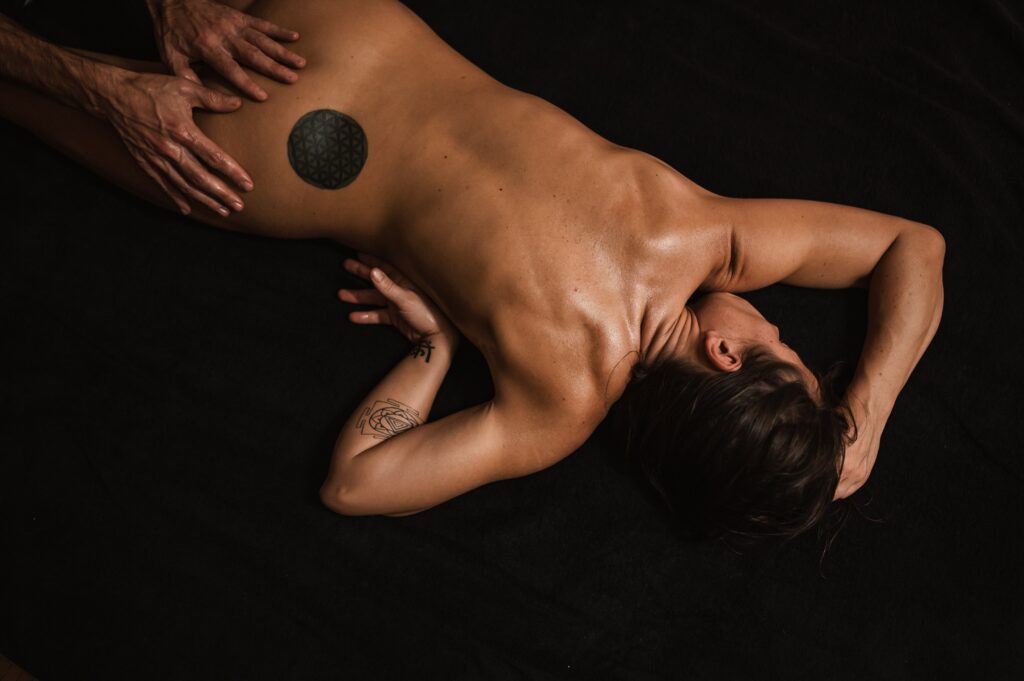Sensate focus is a sex therapy technique that was developed in the 1960’s by William Masters and Virginia Johnson. It takes the focus away from reaching a goal of orgasm or penetrative sex, and puts it onto feeling more sensation in the body.
It is great for those couples where one or both partners are suffering from performance anxiety, pain during sex or difficulties with getting and staying aroused. It is also beneficial in cases where men ejaculate faster than they would like, or experience difficulties with erectile function.
Many times it is easy to make sex a genital and orgasm-as-a-goal focused affair. This can create unconscious habits, and can lead to an unfulfilling sex life for the couple. Sensate focus helps to create new habits, build communication skills and develop mindfulness.
Before Starting
There are five stages of the Sensate Focus technique, and couples are advised to work through them at their own pace. It is usually recommended to have at least a few separate sessions at each stage, and for both to feel comfortable, before moving on. Each time the partners take turns being the giver and receiver, before having a little break and swapping over.
This is something that couples do at home, working their way through the different stages of the technique. Before commencing each session, it is advisable to have a bath or shower (separately at the beginning), and create a beautiful space with pleasant music, smells and low lighting – or whatever works feels pleasant to you.
Stage One
The first stage involves taking it in turns to give and receive touch, but without touching the breasts or genitals. Being naked is encouraged, although if it feels more comfortable to be wearing some clothes, that is also fine. Continue with clothed sessions until you are ready to explore naked.
The focus is on exploration – noticing the temperature, contours, softness or hardness, and other details of your partner’s skin and body. This would normally happen for around 15 minutes, before taking a break and swapping over. The idea is not to try and arouse or sexually stimulate yourself or the partner, nor is it to try and give pleasure. It is just an exploration, without any end goal.
If arousal occurs, then it is recommended to breathe through it, and not to allow it to lead into any sexual activity. Traditionally, this stage would be repeated a couple of times per week for four weeks. Nowadays, it is up to each couple to feel how long they want to spend at this stage before moving on.
The giver is encouraged to explore giving the kind of touch and exploration that they want, but of course the receiver can say no to something that isn’t wanted – the idea is not to have to tolerate or endure anything! Communication between partners is encouraged.
Stage Two
In the second stage, the breasts and genitals are included, but without being a specific focus – they are explored along with other parts of the body. Sexual stimulation or giving pleasure is still not the goal, and, same as in stage one, if arousal occurs it should not lead to sexual activity.
In the second stage, the receiver can start to guide the giver verbally, or by lightly placing their hand over their partner’s hand and moving it to indicate if they would like more or less pressure. This way their partners can learn about what feels pleasurable. The aim is to learn more about each other’s bodies, and there is no intercourse at this stage. Again, partners can spend around 15 minutes as the giver/ receiver, and then swap. This is just a guideline and the time can be lessened or lengthened depending on individual preferences and circumstances. Just ensure that the practice does not go on for so long as to become boring or uncomfortable for either person.
Stage Three
Again, once the couple feel ready to continue, they can move on to the third stage, which is like stage two but with the addition of the use of massage oil for the skin and lubricant for the genitals. Ensure that these are warm – you can use a baby warmer bottle or simply put the oil in a sink of warm water before commencing. Adding oil and lubricant can enhance the sensations of touch, and help with continuing the exploration of each other’s bodies.
Stage Four
Once both partners feel ready to continue, they can move on to stage four, which is mutual touching. The idea is still to focus on exploration, and not trying to arouse each other. Lips and tongues can be included in this stage, but kissing, oral and penetrative sex should be avoided. This helps to avoid old patterns, and keeps the focus on sensuality rather than orgasms.
Stage Five
In the final stage, five, the couple can move on to sexual intercourse or, rather, “sensual intercourse”. By this stage, the couple are likely to be more accustomed to focusing on physical sensations, and are encouraged to notice the temperature, texture and overall feel of the genitals as they touch. Keeping things slow is recommended, being mindful to avoid any instinctive thrusting and keep staying mindful. Varying the breathing, eye contact, communicating and guiding each other can all help here.
How Tantric Therapy Can Help
Coming for a couples’ session can help you to learn some of the mindfulness techniques for using outside of the therapy space. These include working with breath and the five senses, and learning new and different ways to touch self and the other. In addition, we can look for other ways to support you on your journey with additional techniques for delaying ejaculation, getting rid of pain during intercourse, or improving intimacy. These can be as part of the couples’ session, or a stand alone individual session.

